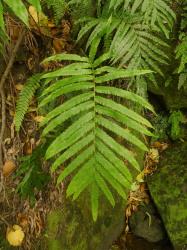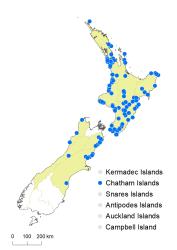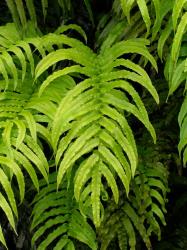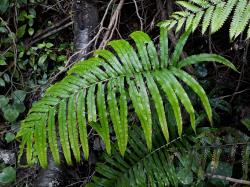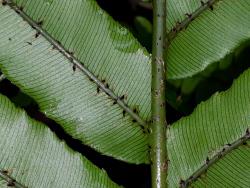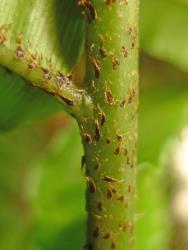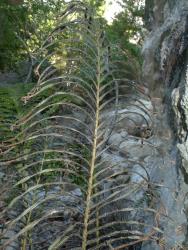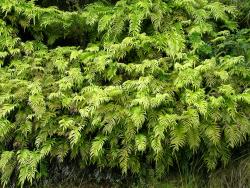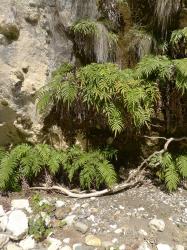- ≡ Parablechnum triangularifolium (T.C.Chambers & P.A.Farrant) Gasper & Salino in Gasper et al., Phytotaxa 275: 217 (2016)
- = Lomaria capense var. carsi Dobbie, New Zealand Ferns ed. 3, 222, f. 76c (1931) – as L. australis var. carsi changed in errata to L. capense var. carsi
Rhizomes erect, up to 60 mm long (in herbarium material), bearing scales. Rhizome scales linear to narrowly ovate, 10–13 mm long, 0.5–1.7 mm wide, dark brown, bicolorous with pale margins. Fronds strongly dimorphic; sterile and fertile fronds of similar habit, arching outwards or hanging downwards; sterile fronds 250–1920 mm long; fertile fronds on same plant usually a little shorter, 200–1230 mm long. Sterile fronds. Stipes 65–1080 mm long, black-brown proximally, yellow-brown distally, bearing dark shiny scales with paler margins. Rachises yellow-brown, grooved adaxially, scaly. Laminae 150–900 mm long, 90–560 mm wide, 1-pinnate, elliptic to ovate, with an undivided apical segment, mid-green on adaxial surface, slightly paler green on abaxial surface, occasionally red-tinged when young, coriaceous; scales on abaxial pinna costae bicolorous with a conspicuous dark spot around the point of attachment. Pinnae in 6–32 pairs, closely to widely spaced, narrowly oblong or narrowly ovate, falcate, not reduced at the lamina base; the longest pinnae in the lower half of the lamina, 110–300 mm long, 9–28 mm wide, apices attenuate or caudate or rarely acuminate, margins undulate and shallowly crenate, bases acute to rounded, sometimes unequally so, shortly stalked; the basal pinnae opposite or alternate. Veins free. Fertile fronds. Stipes 100–550 mm long. Laminae 100–640 mm long, 90–340 mm wide. Pinnae in 12–34 pairs, linear, straight, 55–220 mm long, 2–4 mm wide, not reduced at the lamina base. Sori and indusia in one row either side of costa, continuous along the length of the pinna.
Blechnum triangularifolium is recognised by its dimorphic fronds, free veins, pinnate sterile laminae, and continuous sori. The sterile laminae are elliptic to ovate, divided into falcate pinnae with caudate apices and short-stalked bases. The basal pinnae are opposite or alternate, and not reduced in size. The laminae bear dark, shiny, bicolorous scales on the rachises and pinna costae that have well-defined dark areas and pale margins. The adaxial surfaces are slightly darker green than the abaxial ones, and the fertile fronds are usually a little shorter than the sterile fronds.
Blechnum triangularifolium is similar to four other closely related species with stalked sterile pinnae. It is distinguished by its basal pinnae, which are scarcely reduced in size and rarely less than half the length of those at mid-lamina, unlike those in B. minus and B. novae-zelandiae, which are many times shorter at the base than at mid-lamina. The pinnae are falcate, usually taper to long, caudate, acuminate apices, and are arranged in 6–32 pairs, unlike those in B. procerum, which are straight, have obtuse or rounded apices, and are arranged in 1–12 pairs. B. triangularifolium is most similar to B. montanum, but distinguished by its broader sterile laminae (90–560 mm wide, cf. 60–280 mm wide), greater number of sterile pinna pairs (6–32, cf. 6–20) and pale green rather than bronze or olive-green fronds. B. triangularifolium is a lowland species, whereas B. montanum is a montane or subalpine species found more frequently in the South Island.
North Island: Northland, Auckland, Volcanic Plateau, Gisborne, Taranaki, Southern North Island.
South Island: Western Nelson, Marlborough, Westland, Canterbury.
Chatham Islands.
Altitudinal range: 0–750 m.
Blechnum triangularifolium occurs throughout the North Island from Te Paki to Wellington, but is uncommon north of Auckland and in the Bay of Plenty. It grows in coastal and lowland areas, extending locally into montane districts, reaching 750 m near Mangaweka, Rangitikei. In the South Island it occurs in coastal and lowland regions on both sides of the island, but is very rare south of Banks Peninsula, and apparently absent from the Sounds-Nelson EP. It reaches 300 m in the Awatere Valley, Marlborough. It also extends to the Chatham Islands.
Blechnum triangularifolium is a terrestrial species found in coastal broadleaved and beech forest, under mānuka and kānuka, in light scrub, at forest margins, in coastal habitats, and in the open. It grows on dry slopes, road and river banks, cliffs, rock walls and overhanging rock, in coastal seepages, and in dune slacks. It favours sandstone, mudstone, siltstone, rhyolite, limestone, and calcareous soils.
2n = 56 (Chambers & Farrant 1998) – erroneously attributed to Chambers 1954; see Dawson et al. 2000).



